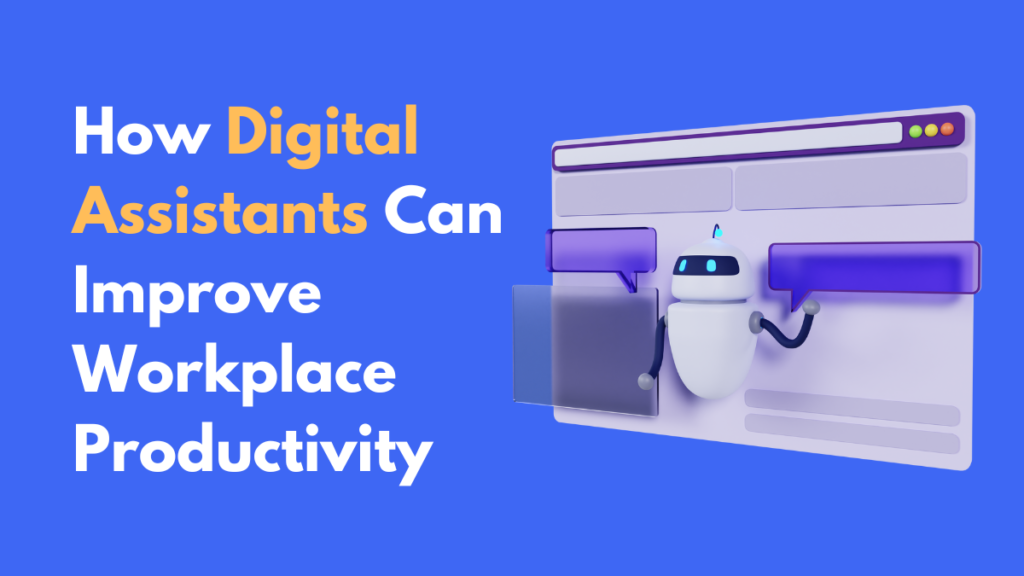Is your workplace productivity struggling? Are you looking for a way to improve efficiency and increase performance in the office? It may be time to consider using digital assistants. Digital assistants have become increasingly popular in recent years, with advancements in artificial intelligence making them sharper and more intuitive than ever before. By leveraging digital assistant technology, businesses of any size can streamline their processes, freeing up valuable resources and allowing employees to focus on the dominant tasks at hand.
In this article, we’ll explore how digital assistants can help boost workplace productivity and take complex organizational systems into the modern age.
Table of Contents
What is Digital Assistant and how can it Work?
Digital assistants are software applications that use Artificial Intelligence (AI) to understand and process natural language, human interactions, and user requests. They can be programmed to carry out tasks ranging from simple commands such as playing music to complex tasks such as providing customer service support or helping with scheduling tasks. For digital assistants to work efficiently, they must be trained to understand the context of a user’s request and respond appropriately. To do this, AI algorithms are used to analyze user speech patterns and convert them into instructions that can be understood by the assistant. The use of digital assistants has grown in popularity over recent years as they become increasingly sophisticated at providing helpful services.

Ways Digital Assistants can Improve Workplace Productivity
1. Task automation
Digital assistants, such as voice-enabled platforms like Alexa and Google Home, can be a powerful tool when it comes to increasing workplace productivity. These assistants can automate routine tasks that would otherwise take an employee a significant amount of time. This automation allows employees to focus on more complex tasks or those requiring human creativity and judgment.
Digital assistants can be used to help manage emails, schedule meetings, order supplies, and materials, set reminders or alerts, track deadlines and progress on projects, and even provide customer support. By using natural language processing, digital assistants can be programmed with the necessary instructions to help employees become more efficient in their work.
2. Information retrieval
Digital assistants such as Alexa, Siri, and Google Assistant make it easier for employees to access information quickly and efficiently. By using voice commands or simple searches, they can find the answers they need without spending time searching through multiple websites or documents. That makes completing tasks faster and more efficient, leading to improved workplace productivity.
Using digital assistants also allows employees to multitask, as they can access the necessary information without leaving their current task. Additionally, digital assistants can provide reminders and updates on tasks that need to be completed throughout the day, which helps keep workers organized and on-task.
3. Multitasking
In the modern workplace, multitasking is essential. It can help employees juggle multiple projects and duties, allowing them to work more efficiently and effectively. Digital assistants are one way to make multitasking easier.
Digital assistants are software programs that use artificial intelligence (AI) to recognize commands and respond accordingly. They have a range of uses, from setting reminders to helping with scheduling and more. In the workplace, a digital assistant can be used to automate mundane tasks, freeing up the employee’s time for other essential duties.
4. Voice control
Digital assistants such as Amazon Alexa, Google Home, and Apple’s Siri are changing the way we interact with technology. These voice-activated systems enable us to control our environment by simply speaking a command. How can voice control improve workplace productivity?
The most obvious benefit of using digital assistants in the workplace is their ability to automate mundane tasks. Simple commands like setting reminders, scheduling meetings, and organizing files can help streamline work processes. That frees up valuable time that would otherwise be spent on tedious manual tasks.
5. Personalization
In today’s digital era, organizations have the advantage of leveraging technology to increase workplace productivity. One such tool is the use of digital assistants. Digital assistants are computer programs that can carry out basic tasks and provide assistance with day-to-day activities. They make it easy for employees to access information quickly, automate certain processes and manage projects.
Conclusion
Digital assistants can help improve workplace productivity in several ways. They can save time by taking care of mundane tasks, such as scheduling meetings and sending emails. Digital assistants also make it easier to collaborate with colleagues, both within the organization and from outside sources. As digital assistants become more commonplace in society, it’s dominant to understand how they could use in the workplace to improve productivity. Digital assistants are just one way that technology is changing the modern workplace. By understanding how they work and how they could use effectively, you can help your team make the most of this new tool.

